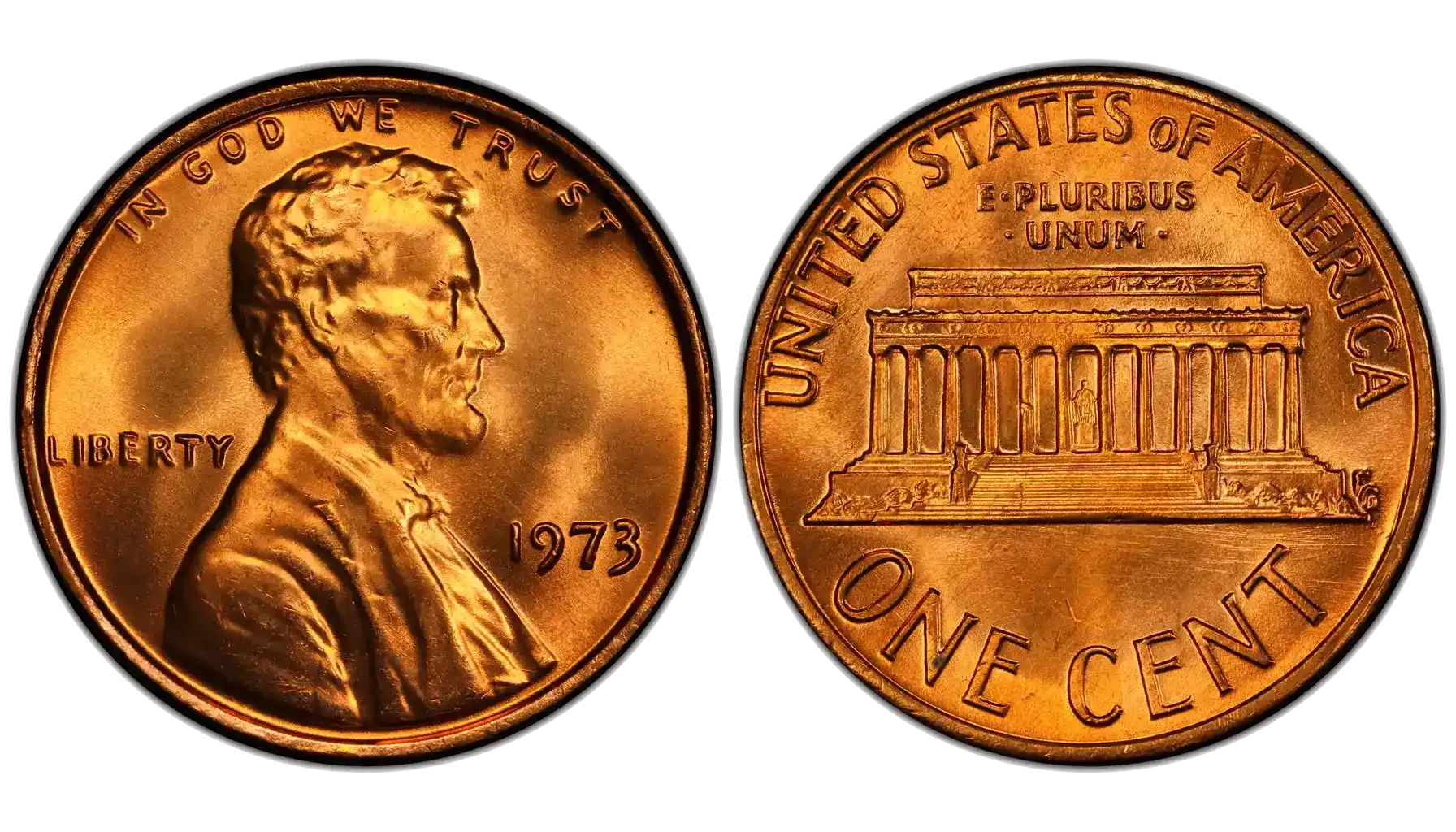Contents:
- Meet the 1972 Eisenhower Dollar: A Presidential Coin with Big Value Potential
- Clad or Silver? Spotting the Metal Type in Your 1972 Dollar Coin
- 1972 Eisenhower Dollar Values: From Pocket Change to Premiums
- P, D, or S? Understanding Mint Marks
- The Rarest Ever Sold
- 1972 Dollar Coin Errors and Varieties
- Three Reverse Types: How to Tell If You Have the Scarce Type 2
- Wait, Was There a 1972 Half Dollar Too?
- Keep or Sell? Tips for Handling
The Eisenhower dollar joined the U.S. coin family in 1971, produced by the United States Mint. In 1972, the mint struck a special edition honoring President Eisenhower and the Apollo 11 moon landing, featuring a bold design with an eagle clutching an olive branch. Its large size and historical significance make it highly sought after by coin dealers and collectors alike. Many enthusiasts prize these pieces for their rich backstory and enduring legacy.
In 1972, the United States Mint’s Philadelphia mints and Denver facility struck two metal types: a 40% silver-clad version and a copper-nickel clad version with no silver. Proof specimens bearing the “S” mint mark showcase a detailed eagle s head alongside the “god we trust” motto. Regular strikes from the Philadelphia (“P”) and Denver (“D”) mints vary in rarity based on mint mark and finish. Collectors use these mint marks and metal compositions to assess each coin’s value.
This guide breaks down each factor. It shows you how to spot mint marks and metal types. It outlines rare varieties and key details. Use these tips to check coin value.
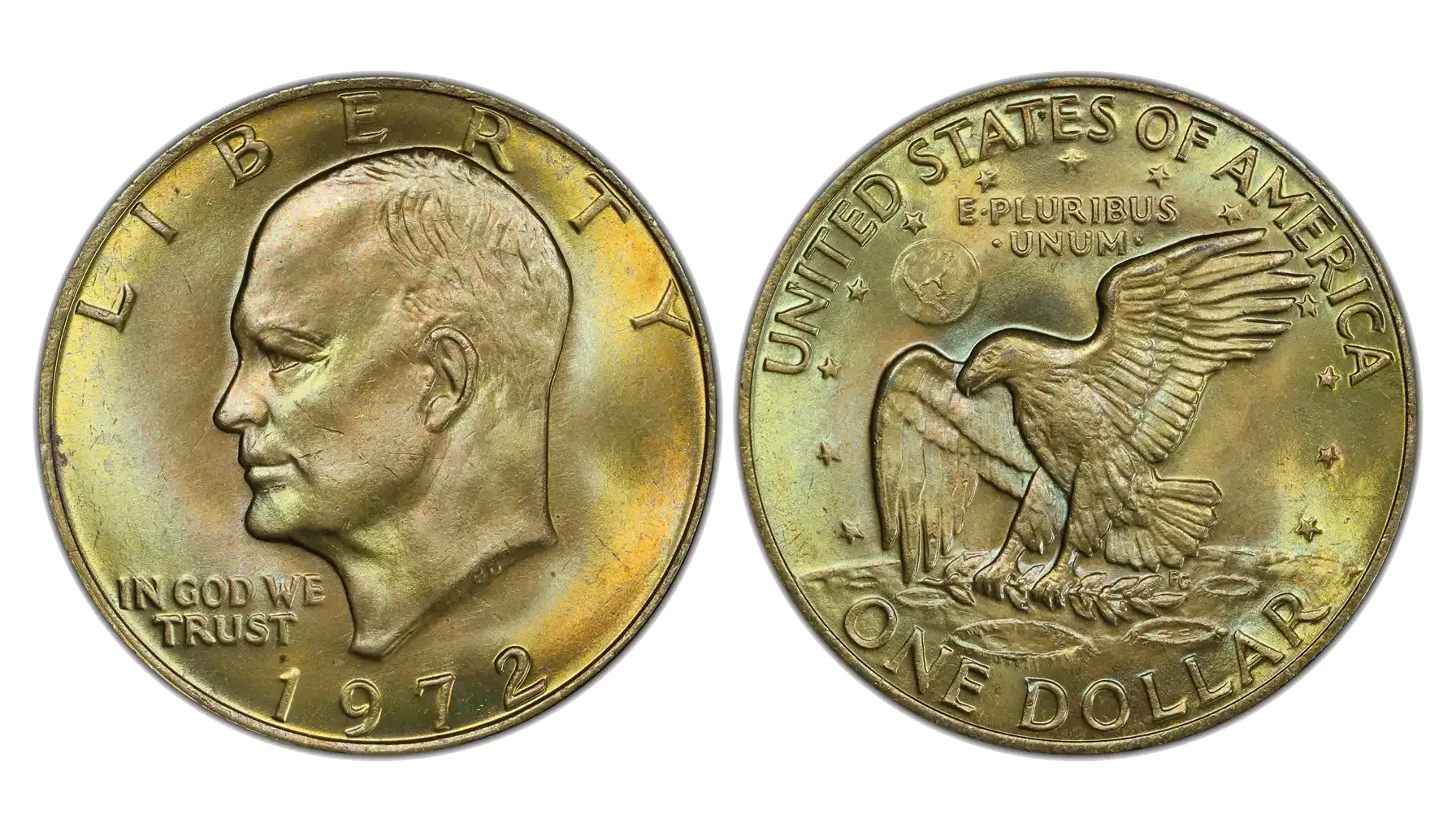
Meet the 1972 Eisenhower Dollar: A Presidential Coin with Big Value Potential
The Eisenhower series began in 1971 to honor President Eisenhower and celebrate the Apollo 11 moon landing. Collectors embraced its bold size and striking design. It carried the same portrait and reverse motif through the early 1970s. The 1972 dollar coin continued that legacy with fresh minting and sharp details.
The U.S. Mint produced two metal versions in 1972. Special issues carry 40% silver in each layer. Regular strikes use a copper-nickel clad composition. Each example shows one of three mint marks. This variety boosts the appeal of the 1972 one dollar coin.
The 1972 US dollar coin saw massive runs at Philadelphia and Denver. San Francisco focused on proof sets. Each mint mark signals a different release. Many collectors chase these distinctions and their relative rarities.
Collectors prize the 1972 United States one dollar coin for its link to both a modern president and mankind’s first lunar steps. It blends post-war artistry with space-age flair. It also marks an era of bold U.S. coinage.
3 key facts that make the 1972 Ike dollar unique
It marks the series’ second annual release with slight design refinements.
It offers both 40% silver-clad and copper-nickel clad versions.
It bears the Apollo 11 mission insignia on the reverse.
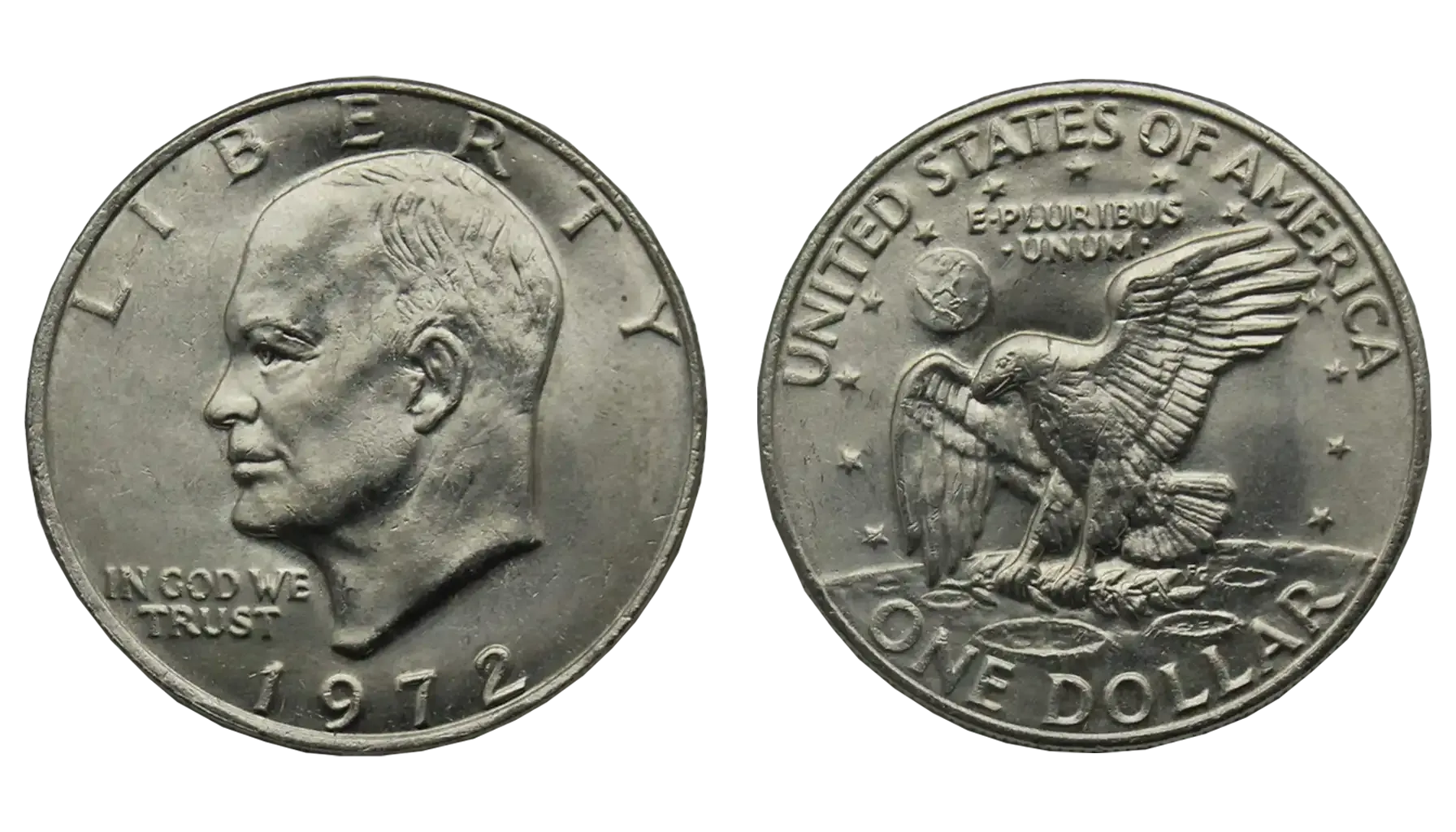
Clad or Silver? Spotting the Metal Type in Your 1972 Dollar Coin
The 1972 dollar coin value depends on metal content. Mint records show two main types. The clad version features copper-nickel layers. The silver version features a 40% silver-clad outer ring.
Collectors check color and finish. The 1 dollar coin 1972 clad strike has a dull gray look. The dollar coin 1972 silver strike has a bright, mirror-like shine. People spot these differences with a quick glance.
Inspect the rim and thickness. The silver type often has a sharper edge and a brighter rim. You can compare it side-by-side with a known piece. Visual cues can lift the dollar coin 1972 value for silver strikes.
Type | Composition | Edge Color |
Clad | Copper-nickel clad layers | Dull gray |
Silver | 40% silver-clad outer layers | Bright, mirror-like |
4 visual signs to spot a silver Eisenhower dollar
Mirror-like shine on both obverse and reverse fields
Bright silver tone on the rim, unlike dull gray clad
Sharper, well-defined reeded edge cuts
Crisp detail on raised design elements
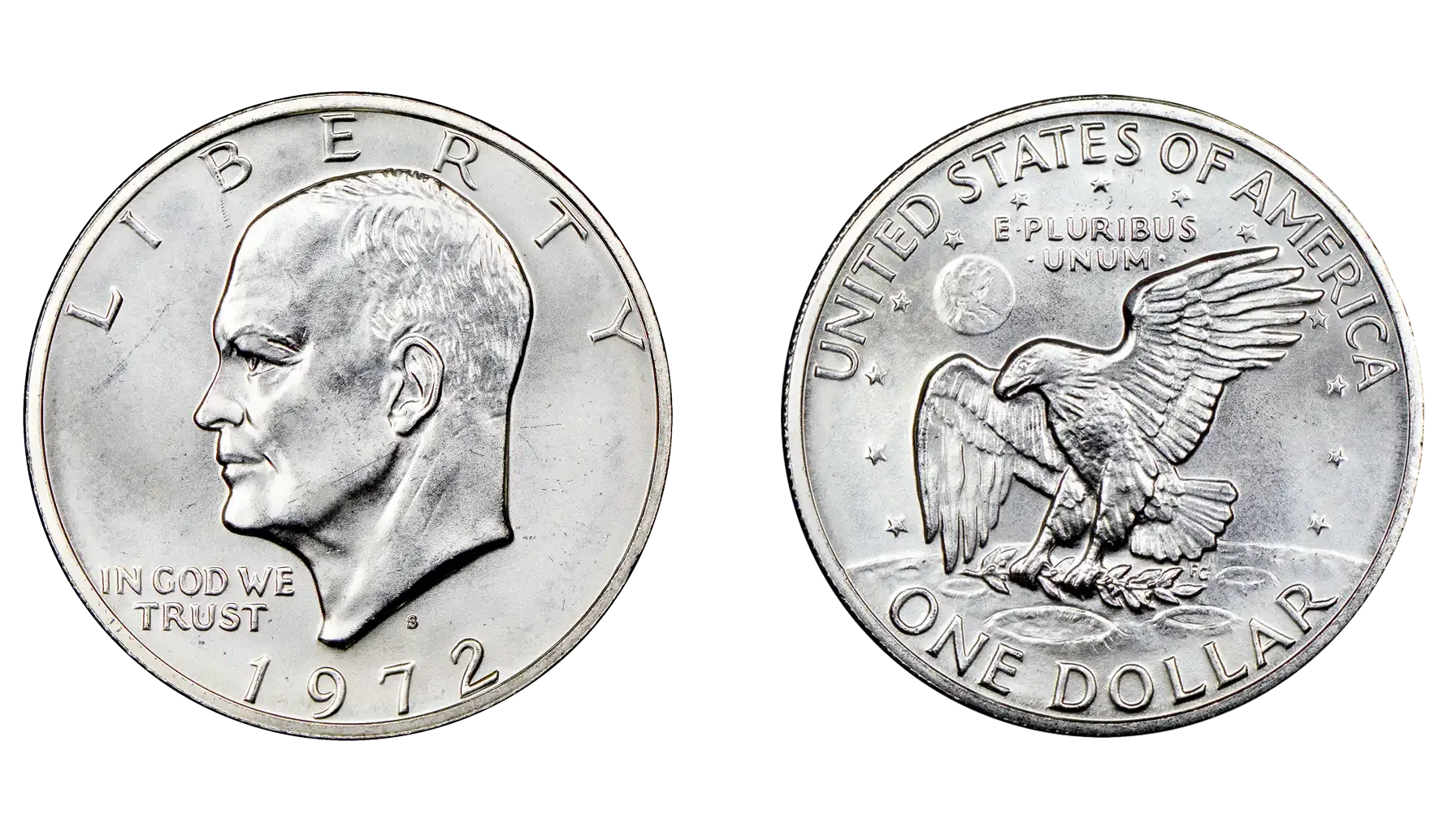
1972 Eisenhower Dollar Values: From Pocket Change to Premiums
Many people wonder how much is a 1972 dollar coin worth when they find one in their change. In low grades the piece trades near its face value. Higher grades draw growing premiums. Rare survivors can sell for tens or hundreds.
Uncirculated strikes often command more value. The 1972 dollar coin worth climbs steadily from MS60 through MS65. Silver proof issues from San Francisco bring even higher prices.
Grade | Philadelphia (Clad) | Denver (Clad) | San Francisco (Proof Silver) |
Circulated | $1.00 – $1.25 | $1.00 – $1.25 | $1.50 – $2.00 |
MS60 | $3 – $5 | $3 – $5 | $6 – $8 |
MS63 | $5 – $8 | $5 – $8 | $10 – $12 |
MS65 | $15 – $20 | $15 – $20 | $25 – $30 |
MS67 | $40 – $60 | $40 – $60 | $150 – $200 |
3 grading terms every collector should know
Good (G) – shows heavy wear and low detail
Very Fine (VF) – shows moderate wear with clear design
Mint State (MS) – shows no wear; grades run MS60 to MS70
Collectors track the one dollar coin 1972 value and compare mint marks. They check both P and D business strikes and S silver proofs. Top-grade examples fetch peak prices. The 1972 1 dollar coin value can exceed $200 in MS67.
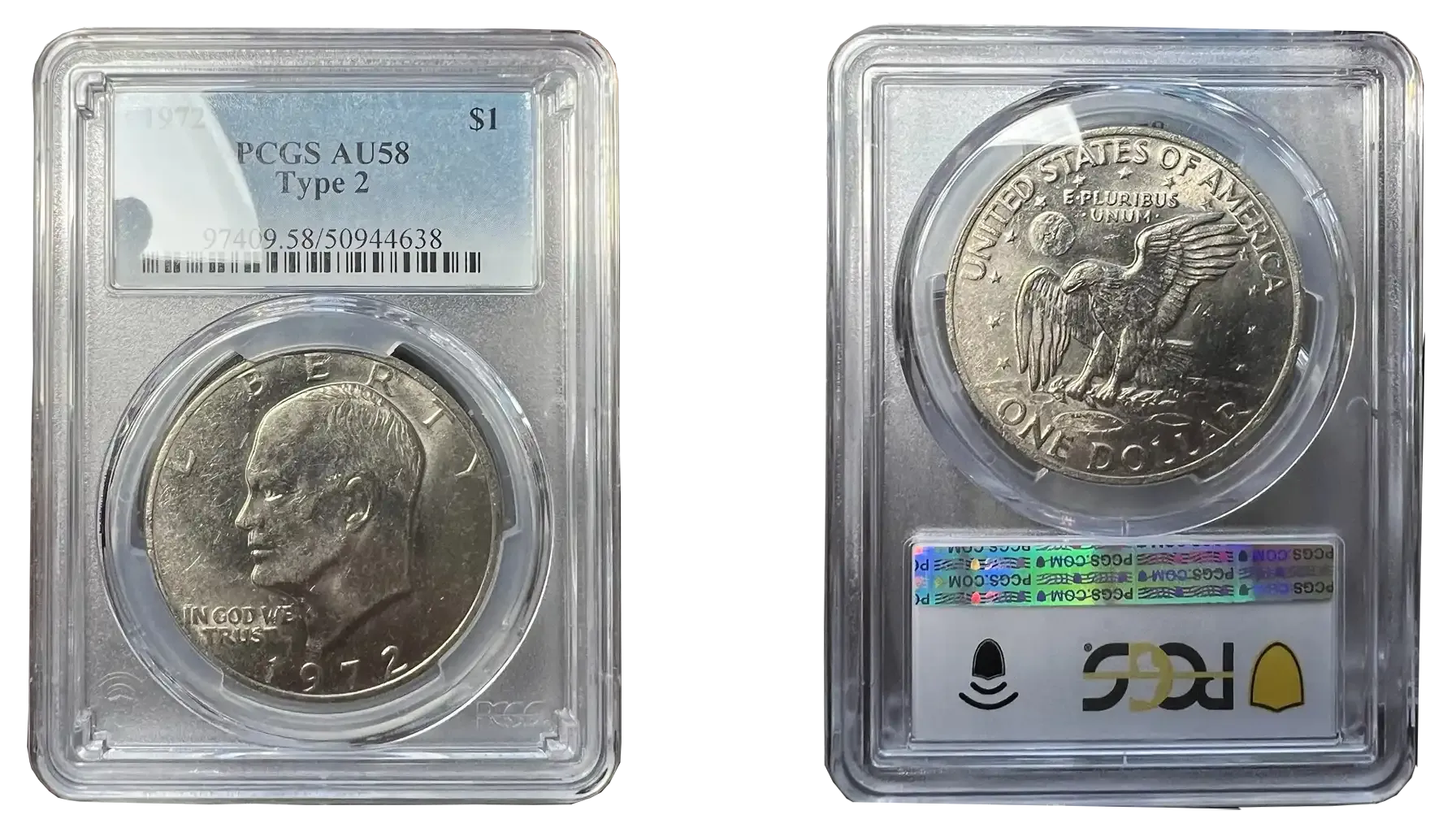
P, D, or S? Understanding Mint Marks
Eisenhower pieces bear mint marks on the obverse. Look just above the date and below Eisenhower’s neck. Pieces from Philadelphia carry no symbol. Those issues are often listed as 1972 dollar coin no mint mark and represent the standard business strikes.
The Denver Mint adds a D mark on obverse. You will find it above the date on the right side. Collectors note this symbol to distinguish Denver strikes. Many refer to 1972 D one dollar coin value when tracking Denver business issues.
Pieces from San Francisco bear an S mint mark in the same spot. Those examples often serve as proofs or special silver strikes. Collectors compare them with Denver issues to gauge premiums. Market guides list 1972 D dollar coin value and show how D and S coins stack up.
Online listings may use different naming styles. Some sites list 1972-d one dollar coin value with a hyphen for Denver strikes. That style can help match specific search results for the D mint mark.
Understanding these marks helps you identify origin and rarity. Searching for 1972 dollar coin value no mint mark reveals value ranges for unmarked Philadelphia business strikes. For a deeper dive into mint mark details, check the 1972 Silver Dollar Value guide.
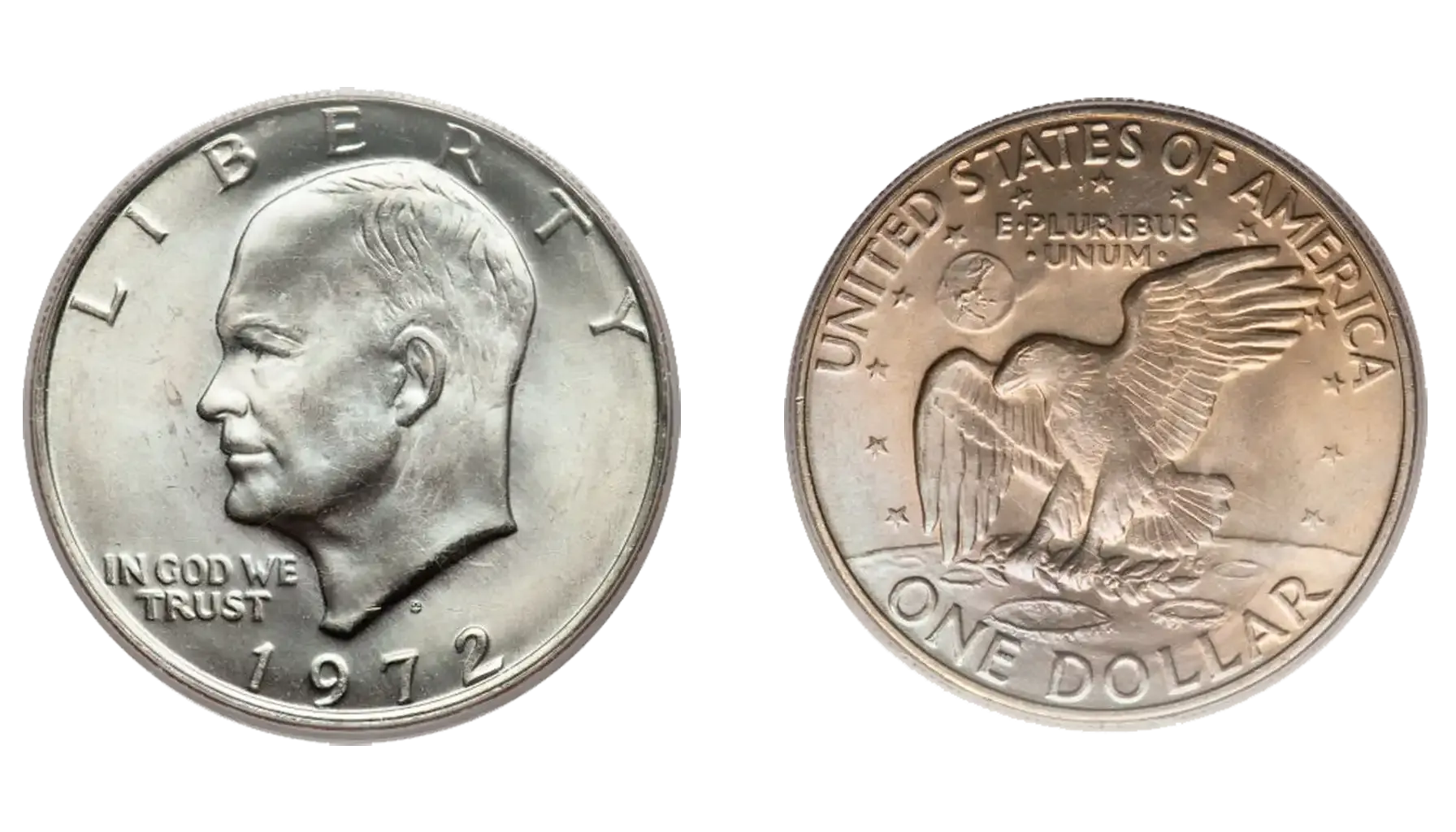
The Rarest Ever Sold
Collectors chase the highest-grade pieces at major auctions. Rare examples can shatter previous price records. Dealers and bidders bid fiercely for top-tier coins. The most valuable 1972 dollar coin value keeps climbing with each standout sale.
Grading services certify these rare survivors to guarantee authenticity and condition. PCGS and NGC verify Mint State and proof designations. Auction houses then showcase them to global audiences. The Eisenhower 1972 dollar coin value often spikes when fresh records emerge.
Here we highlight the five record-breaking sales that underscore the 1972 Eisenhower dollar coin’s premium potential:
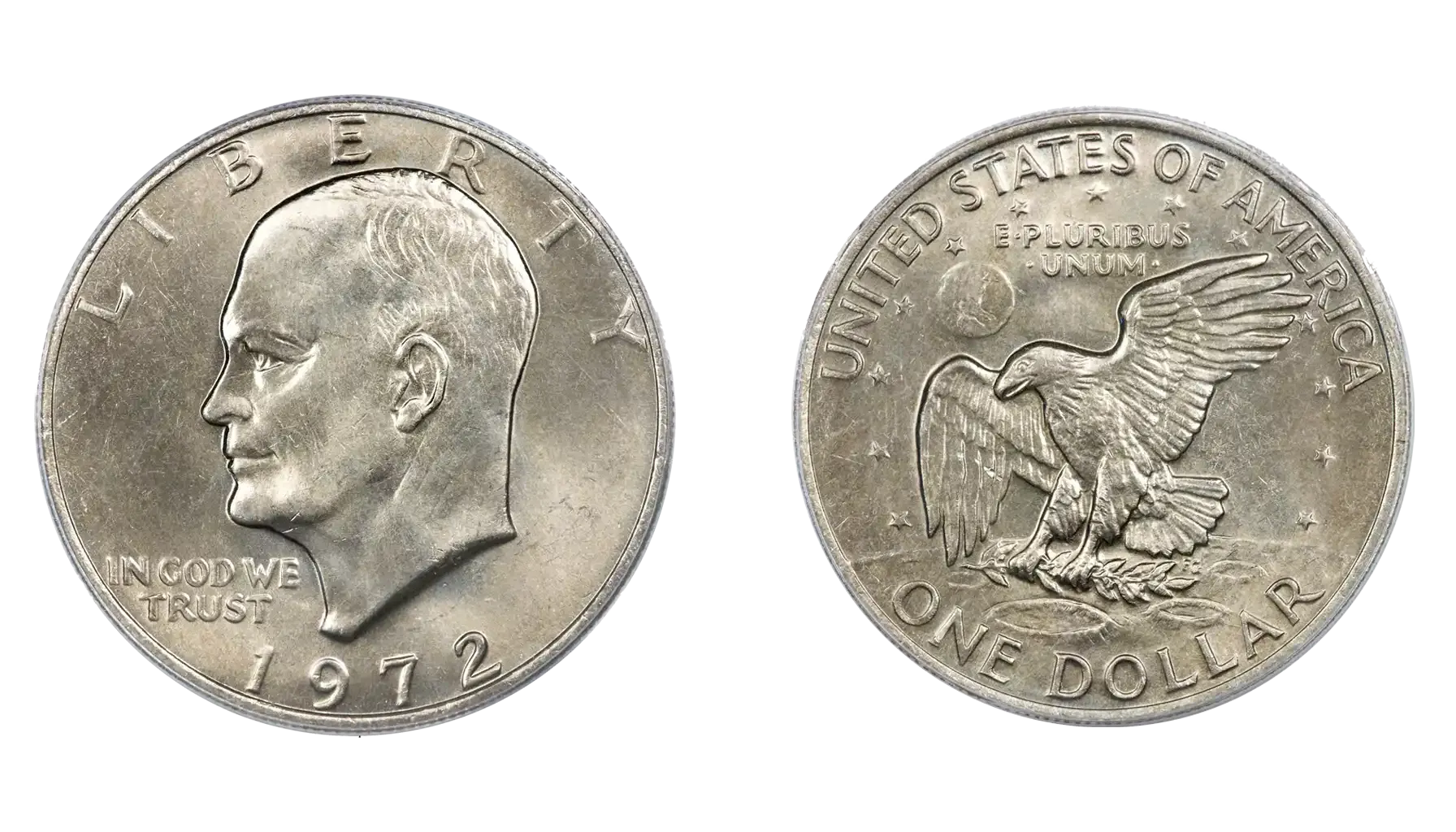
Type | Grade | Sale Price | Auction House | Sale Date |
1972-S Uncirculated Silver Ike | PCGS MS67 | $5,750 | Heritage Auctions | September 21, 2005 |
1972-S Silver Proof Ike (Deep Cameo) | PCGS PR70 DCAM | $4,715 | Heritage Auctions | April 25, 2002 |
1972-D Clad Business Strike | PCGS MS67 | $9,775 | Heritage Auctions | July 2011 |
1972-D Clad Business Strike | PCGS MS67+ | $13,200 | Heritage Auctions | July 23, 2023 |
1972-D Clad Business Strike | NGC MS67 | $900 | Stack’s Bowers | November 2024 |
1972 Dollar Coin Errors and Varieties
Error and variety coins can carry top premiums. Wrong planchets, doubled dies, and other oddities drive strong collector interest. Each misstrike tells a story. Mistakes can boost the 1972 Eisenhower dollar coin value far above regular issues.
Collectors chase rare types like off-center strikes and clipped planchets. Experts track doubled die obverses and repunched mint marks. They rely on grading to confirm authenticity. Errors can lift the Eisenhower 1972 dollar coin value to record levels.
PCGS curates a detailed list of known errors and varieties. It helps collectors spot and confirm each flaw. Errors can drive Eisenhower 1972 dollar coin value to record highs.
4 key error types found on 1972 Ikes
Off-center strikes
Clipped planchets
Doubled die obverse
Missing edge reeds
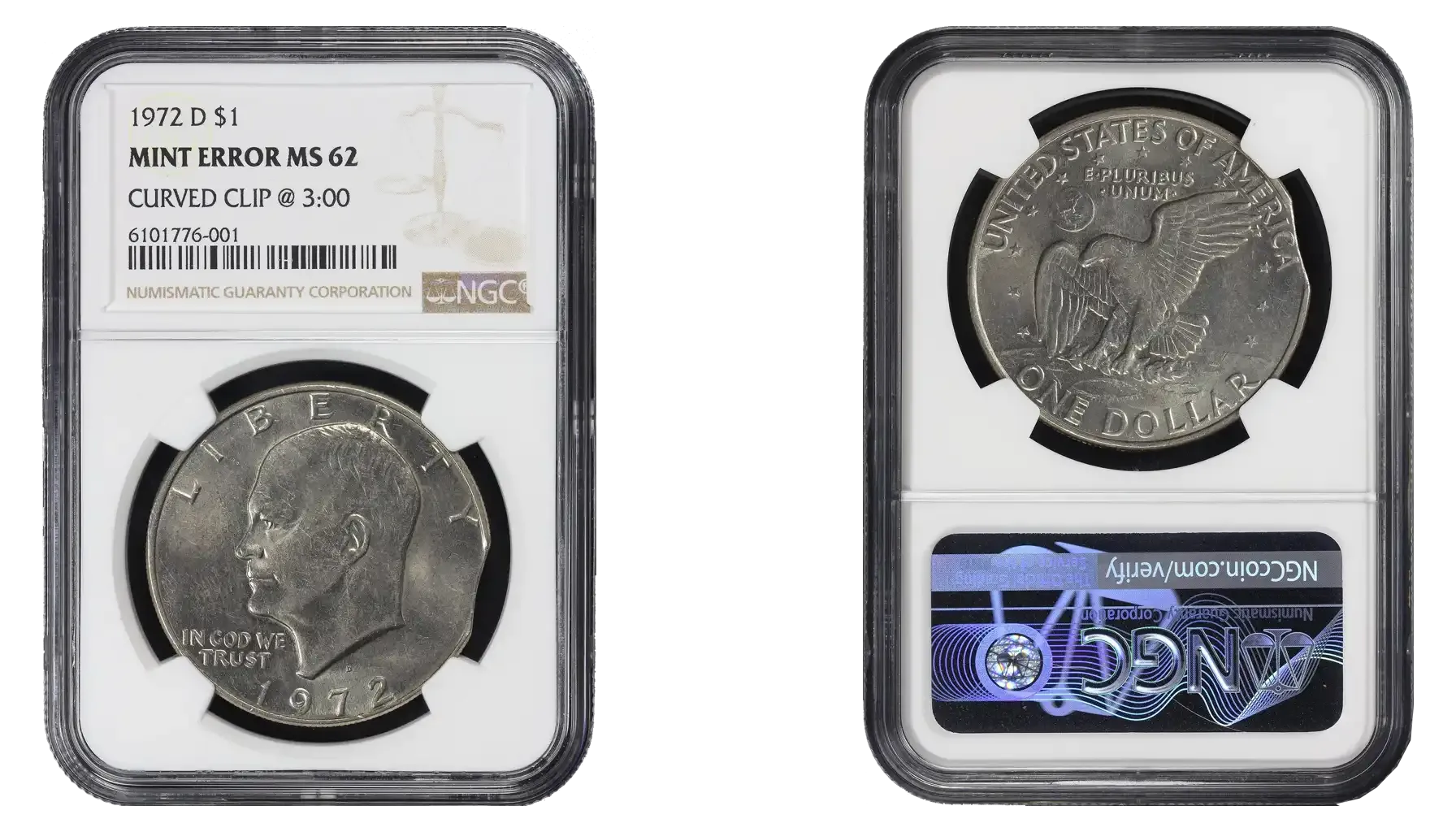
Three Reverse Types: How to Tell If You Have the Scarce Type 2
Experts split the 1972 Ike’s reverse into three minor variations. Each type shows subtle changes in the moon’s crater shape and letter styling. Collectors use these details to pin down the variety. Spotting the scarce Type 2 can boost your 1972 one dollar coin value.
Type 1 shows a shallow, smooth crater behind the eagle. The lettering appears bold and close-set. Many early strikes display this look. You can compare it with later types to rule out Type 2.
Type 2 offers a sharper crater rim and more distinct lunar details. The letters on “United States of America” look finer and more spaced. These remain scarcer than Type 1 and Type 3. Finding one can answer how much is a 1972 one dollar coin worth for this variety.
Type 3 finished the run with a broader, softer-edged crater and widely spaced, thin lettering. It represents the final die change of 1972. Collectors often miss this subtle shift until they compare all three. For a full comparison, see the 1976 Silver Dollar Value guide.
Feature | Type 1 | Type 2 | Type 3 |
Moon/Crater Shape | Shallow, smooth crater | Sharper rim, distinct cratering | Broader crater with soft edges |
Lettering | Bold, close-set letters | Fine, more widely spaced letters | Thin, widely spaced letters |
3 visual ways to tell Type 2 apart from Type 1 and 3
Look for a crisp, well-defined crater rim behind the eagle
Check for finer, evenly spaced lettering around the top edge
Compare against a known Type 1 or Type 3 to spot the sharper relief
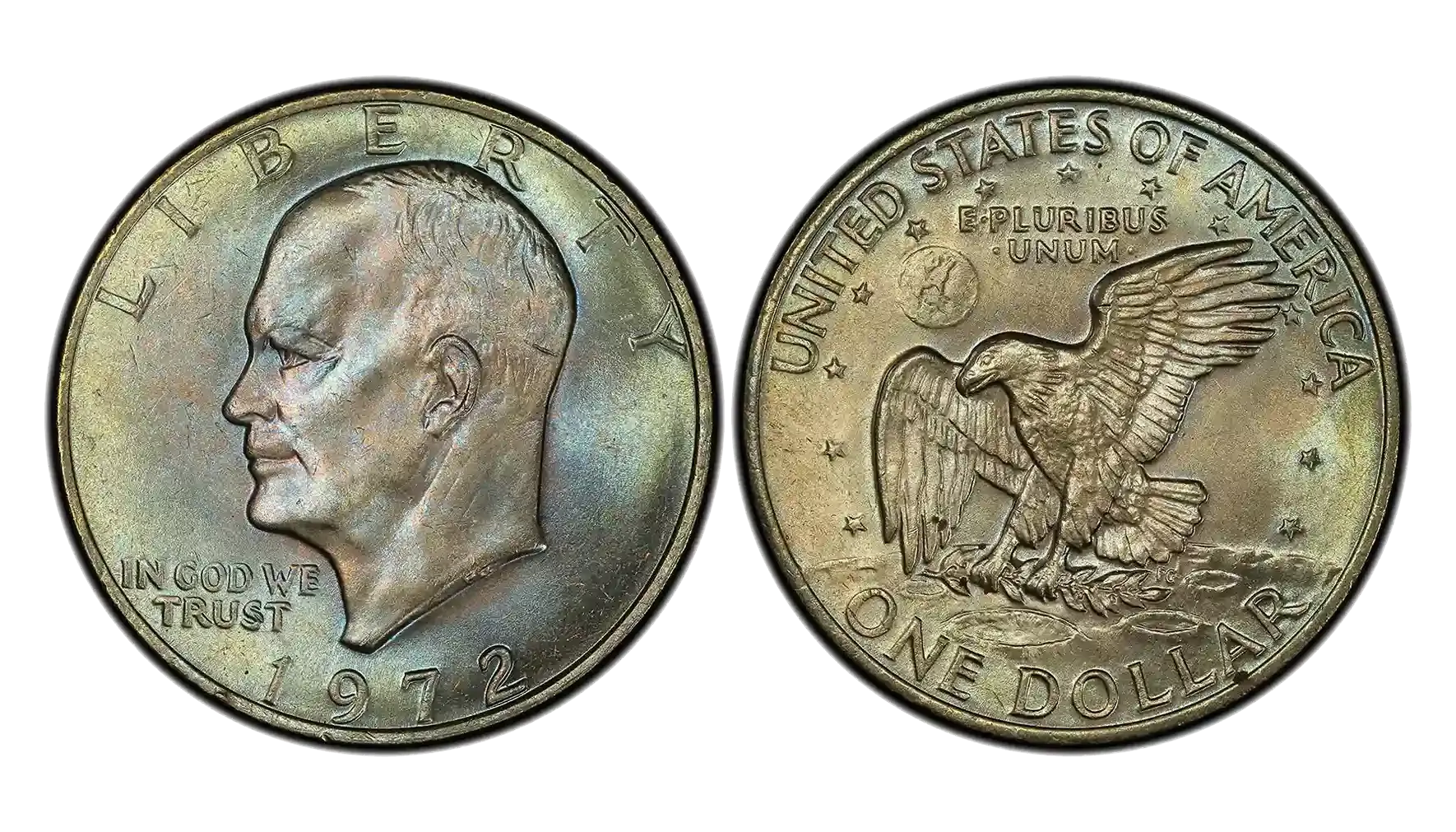
Wait, Was There a 1972 Half Dollar Too?
The U.S. Mint struck the 1972 half dollar coin to honor President Kennedy. Many people confuse it with the larger Eisenhower dollar. The Kennedy half measures 30.6 mm in diameter and shows John F. Kennedy’s portrait. It carries the same 40% silver content in its special issues.
Collectors track the 1972 half dollar coin value by grade and strike type. Circulated business strikes trade near face value. Silver proof and special mint sets earn higher premiums. Both halves and dollars remain staples in many collections.
Differences between Kennedy half and Eisenhower dollar
Denomination & Size: Half dollar = 50 ¢ (30.6 mm), Eisenhower dollar = $1 (38.1 mm)
Portrait: Kennedy half features JFK; Ike dollar shows President Eisenhower
Reverse Design: Half shows the Presidential Seal; dollar shows the Apollo 11 insignia
Silver Content: Both proofs carry 40% silver, but business strikes differ in availability
Edge & Weight: Half has a reeded edge at 11.34 g; dollar has a reeded edge at 22.68 g
Keep or Sell? Tips for Handling
Place your coin in an inert holder. Keep it away from sunlight and moisture. Do not use PVC flips or harsh cleaners. Preserve your coin’s liberty 1972 one dollar coin value. Submit high-grade pieces to PCGS or NGC for grading.
List your coin struck at the San Francisco Mint—including blue Ike and brown Ike varieties—with clear photos highlighting its precious metals content and proof that it’s a 1972 Eisenhower silver dollar commemorating President Dwight D. Eisenhower and the landing on the moon.
Time your sale to coincide with major shows to attract serious collectors. To ensure buyers can find your listing, include all relevant keywords—coin struck, blue Ike, brown Ike, precious metals, 1972 Eisenhower silver one, President Dwight D. Eisenhower, San Francisco Mint, and landing on the moon—and use platform filters to boost visibility.

